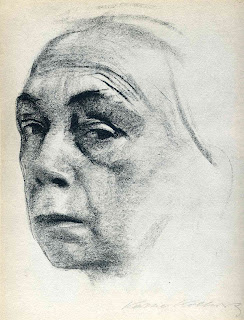Georgia O’Keeffe and Kathe Kollwitz
are two influential women artist who grew up in very different worlds and have
their own personal artistic style. O’Keeffe grew up on a farm in Wisconsin and
her work focused on nature of the Southwest. Kollwitz grew up in a town called
Konigsberg in Russia. Her work places an emphasis on self-portraits,
mother-daughter relationships, hardships of the working class, war and death.
Although they are very different artists, they have both become influential women in the art world.
Georgia
O’Keeffe studied at the School of the Art Institute in Chicago and the Art
Students League in New York. In these years, she supported herself by teaching
art and by 1912 she was teaching art in Amarillo, Texas. This is how her love
for the Southwest began. O’Keeffe got her start by a friend going back on a
promise she had made to O’Keeffe. The friend promised to keep the drawings that O'Keeffe showed her private, but she showed the drawings to artist and photographer, Alfred Stieglitz.
By 1917 O’Keeffe had her very own solo show.
O’Keeffe
moved to New York and married Stieglitz in 1924. They had a very unconventional
marriage because O’Keeffe spent most her time in the Southwest and Stieglitz
spent his time in New York. O’Keeffe marched to the beat of her own drum. She
only dressed in black and she only associated herself with people that she
thought were stimulating and interesting. O’Keeffe shows a lot of balance and
symmetry in nature with her paintings. O’Keeffe also uses a lot of color in
painting: they are bright, vibrant, and strong.
 |
|
Georgia O’Keeffe. Bella
Donna. 1939.
|
 |
|
Georgia O’Keeffe. Cow’s
Skull with Calico Roses. 1931.
|
 |
|
Georgia O’Keeffe. Deer’s
Skull with Pedernal. 1936. Oil on Canvas.
|
 |
|
Georgia O’Keeffe. Summer
Days. 1936.
|
Kollwitz
was trained in Berlin and Munich where she received the best art training for
women at that time. She trained as a painter but soon realized that her passion
wasn’t in painting, it was in drawings and etchings. Kollwitz identified herself as a
socialist and felt the struggles of the working people and the struggles of
women to keep their children safe in a war torn Europe. You can see these
themes in her art work. Kollwitz herself lost her son during WWI and her
grandson in WWII. Kollwitz felt that she needed to be an advocate for the women
and children who were affected by the war and she did that by using her gift as
an artist.
Kollwitz’s
drawings and etchings are very eerie. You can feel the struggle and pain that
the piece emits. O’Keeffe’s messages are not as direct, but they are beautiful and
she conveys a strong message with her symmetry and balance. We haven’t learned
a lot about women artists until now. I wish that they were more prevalent in art
history, but I did enjoy learning more about Georgia O’Keeffe and Kathe Kollwitz.
 |
|
Kather Kollwitz. The
Parents. 1922
|
 |
| Kathe Kollwitz. The Sacrifice. 1922. Woodcut |
 |
|
Kathe Kollwitz. The
Widow from War. 1923. Woodcut
|
 |
|
Kathe Kollwitz. Self-Portrait.
1924
|
No comments:
Post a Comment